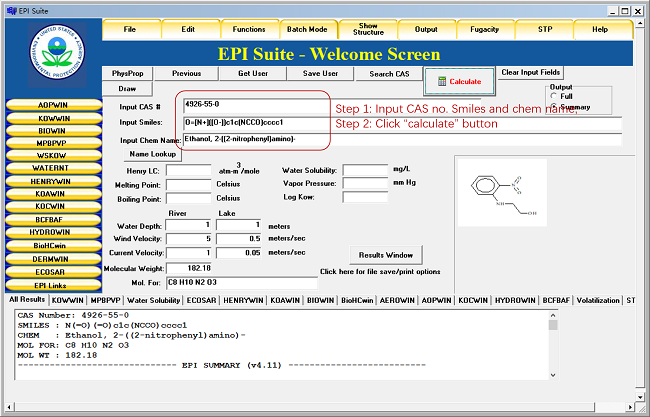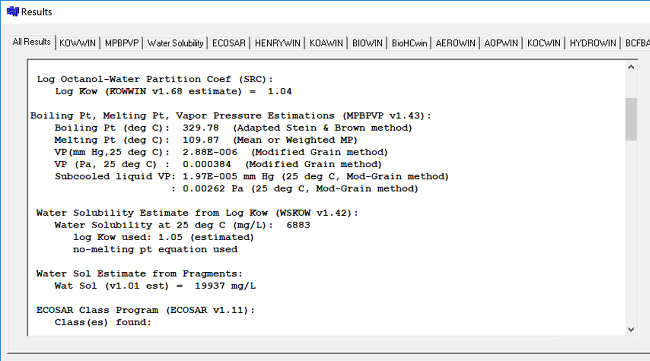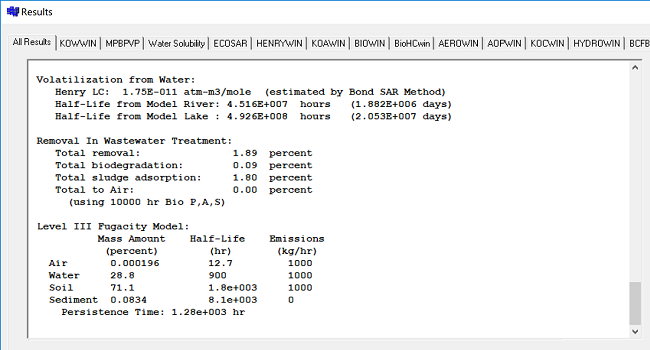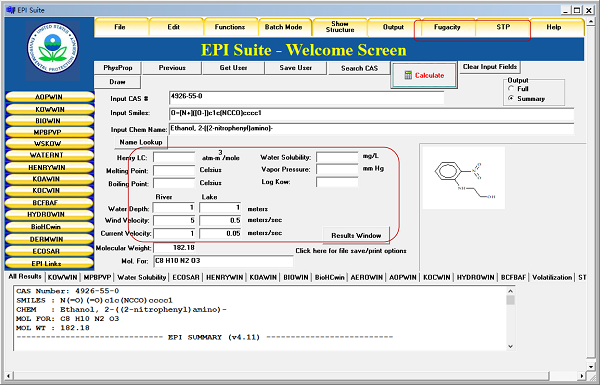How to Use US EPA EPI Suite to Predict Chemical Substance Properties
Little Pro on 2017-09-14
The EPI (Estimation Programs Interface) Suite™ is a suite of physical/chemical property, aquatic toxicity and environmental fate estimation programs jointly developed by US EPA and Syracuse Research Corp. (SRC). It has now become one of the most frequently used QSAR models in the world. In this article, we will show you what EPI Suite can do and how to use it.
Which Chemical Properties Can Be Predicted by EPI Suite
EPI Suite™ consists of the following estimation programs.It only requires a single user input to predict all chemical properties listed below.
|
Programs |
Predicted properties |
|
KOWWIN™ |
Log octanol-water partition coefficient, log KOW |
|
AOPWIN™ |
Gas-phase reaction rate for the reaction between the most prevalent atmospheric oxidant, hydroxyl radicals, and a chemical |
|
HENRYWIN™ |
Henry’s law constant |
|
MPBPWIN™ |
Melting point, boiling point and vapor pressure of organic chemical substances |
|
BIOWIN™ |
Aerobic and anaerobic biodegradability of organic chemical substances |
|
BioHCwin |
Biodegradation half-life for compounds containing only carbon and hydrogen (i.e. hydrocarbons). |
|
KOCWIN™ |
Organic carbon-normalized sorption coefficient for soil and sediment |
|
WATERNT™ |
Water solubility |
|
BCFBAF™ |
Fish bioconcentration factors |
|
HYDROWIN™ |
Aqueous hydrolysis rate constants and half-lives |
|
STPWIN™ |
This program predicts the removal of a chemical in a typical activated sludge-based sewage treatment plant. Values are given for total removal and three processes that may contribute to removal: biodegradation, sorption to sludge, and air stripping. |
|
LEV3EPI™ |
This program contains a level III multimedia fugacity model and predicts partitioning of chemicals among air, soil, sediment, and water under steady state conditions for a default model "environment". |
|
ECOSAR™ |
Short-term and long-term aquatic toxicity |
How to Use EPI Suite
EPI Suite is free of charge. It can be downloaded via this link. You will need to download and install Microsoft .NET Framework 2.0 Service Pack 2 first before you can install EPI Suite on your computer and run it. Currently, EPI Suite only works with Windows operation system.
After you have successfully installed EPI Suite on your computer, you shall be able to see the following screen. To start using EPI Suite to predict chemical substance properties, you only need to input chemical name, CAS no. and Smiles code and then click "calculate" button.

Example: Ethanol, 2-((2-nitrophenyl)amino)-
Let's assume that we need to use EPI Suite to predict the physio-chemical properties and environmental behavior of a chemical substance due to lack of test data. The following info is the minimum info that you need to input to the EPI Suite.
- Chemical name: Ethanol, 2-((2-nitrophenyl)amino)-
- CAS no.: 4926-55-0
- Smiles: O=[N+]([O-])
c1c(NCCO) cccc1
After you have clicked "calculate" button, you should be able to see the following result window popping up.


If you wish to see more than results, you can change output mode from "summary" to "full".
What Can We Learn from Abov Estimations
With above estimations, we can learn many things about the substance Ethanol, 2-((2-nitrophenyl)amino)-:
- Estimated logPow is only 1.04. Its bio-accumulation potential must be very low since bio-accumulation is usually associated with large logPow (i.e, >5).
- Estimated melting point is 102 celcius degrees (high). It must be a solid substance under room temperature (25 celcius degrees).
- The substance is soluable in water. (2 water solubility given: 6883mg/L, 19937mg/L).
- STP cannot effectively remove this substance from waster water. The total removal rate by STP is only less than 4 percent.
- The substance will largely end up in water and soil if released to the enviroment (as predicted by fugacity model).
How to Refine EPI Suite Assessment?
If some measured data is available, you can input them to EPA Suite to do a refined assessment. This customized data might include water solubility, logPow, Henry's law constant, melting point, boiling point and so on. You can also specify water depth, wind velocity and water flow rate. In addition, you can input measured degradation half-lives and estimated emission values in "fugacity" and "STP" section.

What Is SMILES and How to Find It
SMILES (Simplified Molecular Input Line Entry System) is a molecular text code of displayed chemical STRUCTURE. It is required as input by many QSAR models. For a big majority of chemical substances, you may find SMILES via the links below.
An online SMILES translator is available from the National Cancer Institute at http://cactus.nci.nih.gov/services/translate/. For a brand new chemical substance, you usually need to draw its chemical structure using commercial software. The software will then give you the SMILES code.
Related Info
- When to Use QSAR for Chemical Substance Registration and Common QSAR Models
- Introduction to EPI Suite by US EPA
Having Questions?
We do not provide consultancy services. If you have questions or need any help, please contact our sponsor. You may also find an expert in CSP business directory below. If you are a consultant, you may get yourself listed in CSP business directory (free) or sponsor this page to leave your contact info on this page..

Tags: Topics - CRA, Chemical Risk Assessment Tutorials